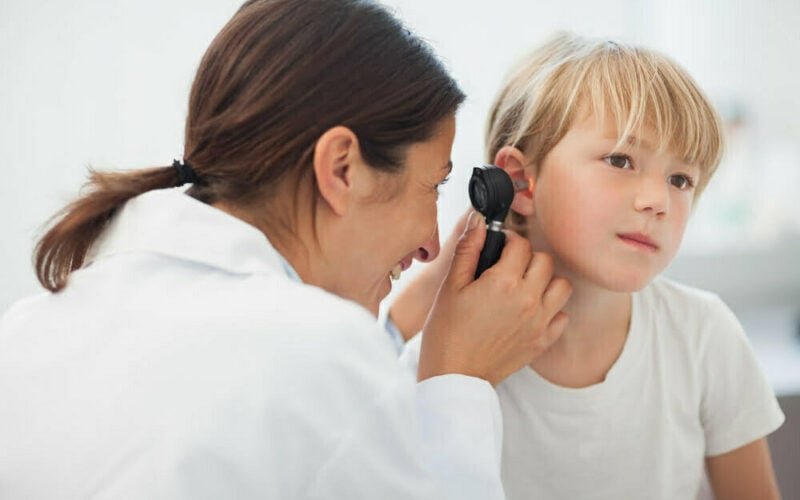Dairy and Childhood Ear Infections

Dairy is a type of food that is derived from animal milk, such as cow’s milk, goat’s milk, or sheep’s milk. Dairy products include milk, cheese, yogurt, butter, and cream. These products are a good source of protein, calcium, and other nutrients, and are a staple in many people’s diets.
Childhood ear infections, also known as otitis media, are a common ailment that affects many children. The infection occurs in the middle ear, which is located behind the eardrum. Symptoms of an ear infection may include ear pain, fever, and difficulty hearing.
Risk of childhood ear infections
There is some evidence to suggest that dairy consumption may increase the risk of childhood ear infections. One theory is that dairy products can stimulate the production of mucus in the body, which can contribute to the development of ear infections. Additionally, some children may be allergic or sensitive to dairy, which can also increase the risk of ear infections.
However, it’s important to note that not all children who consume dairy will develop ear infections, and not all ear infections are caused by dairy consumption. Other factors, such as genetics, exposure to secondhand smoke, and a weakened immune system, can also play a role in the development of ear infections.
More about dairy and its connection to childhood ear infections. Dairy and other allergenic foods are associated with recurrent ear infections in children.
Every parent should know this
Every primary care doctor should know this.
Nearly 50% of recurrent ear infections in children are caused by food allergies! Does this sound like I’m on a bit of a soapbox? I admit it. Because several studies that show the food allergy-ear infection connection is still virtually ignored in mainstream medicine. The first thing any primary care practitioner should be doing with an infant or child who has ear infections is recommending a trial off dairy, and if that doesn’t work, looking for other food allergens.
Trial off dairy
Here’s a good example of what gets done instead. One of my dairy allergic patients had been taking her 18 month son to his pediatrician for ear infections, since he was just a few months old. She had not been in to see me since he was born–she was doing fine on her own allergen free diet and was too busy with the baby. But finally, she came in to ask me about him, because after quite a few infections they were proposing doing surgery to put tubes in his ears, and she wanted to know if there was an alternative. I immediately suggested a trial off dairy, and that was the end of his problems with his ears, and the ear tube surgery was avoided.
I am going to be hard core here and include the actual medline abstract of one of the most recent studies about food allergy and ear infections right in this blog. It is from the prestigious medical journal Otolaryngology-Head and Neck Surgery (The official journal of the American Academy of Otolaryngology-Head and Neck Surgery Foundation, Inc. Volume 130, Issue 6, Pages 747-750 (June 2004.) This is just a mere indication of how tired I am of hearing “there are no studies.”
“The Role of Food Allergy in Otitis Media With Effusion
By Barlas Avodgan, MD, Mete Kiroglu, MD, Derva Altinatas, MD, Mustafa Yilmas, MD, Edis Yorgancilar, MD, Ulku Tuncer, MD
Abstract
Objective
To detect the relationship between food allergy and otitis media with effusion (OME).
Materials and Methods
This study was performed on three different groups. The patient group was made of 56 patients with OME (group I). There were 28 patients with food allergy in group II, and these patients were investigated for OME. The control group consisted of 28 patients without any complaints concerning food allergy or OME (group III).
Results
Food allergy was detected in 25 patients with OME (44.6%) (group I). In patients with food allergy (group II), OME was detected in 7 patients (25%). In the control group (group III) food allergy was diagnosed in 5 patients (18%) and OME in 1 patient (3%). The incidence of food allergy in OME group was statistically significant when compared to the normal group (P > 0.05).
Conclusions
This study demonstrates that food allergy may play a role in the etiopathogenesis (cause) of OME”
End of study abstract.
So here’s what the abstract says–nearly half the patients (44.6%) with ear inflammation/infection/effusion (OME) had food allergies, and 25% of the patients with known food allergies had ear inflammations. However, in the control group, only 5 patients (18%) had food allergies and 1 patient had an ear inflammation.
And furthermore!!! Here are citations of other medical articles that make this connection between food allergies and recurrent ear inflammations and infections.
Bottom line: If your child has repeated ear infections, think food allergy, and find a doctor who understands the connection, and tests for delayed-type food allergies, as well as doing scratch tests.
If your child is experiencing symptoms of an ear infection, it’s important to see a doctor for proper diagnosis and treatment. In some cases, antibiotics may be prescribed to help clear up the infection. Additionally, limiting dairy consumption or avoiding dairy altogether may be recommended for some children, depending on their individual needs and health status.
1. McMahan JT, Calenoff E, Croft J, et al. Chronic otitis media with effusion and allergy: modified RAST analysis of 119 cases. Otolaryngol Head Neck Surg 1981;89:427–31.
2. Nsouli TM, Nsouli SM, Linde RE, et al. Role of food allergy in serous otitis media. Ann Allerg 1994;73:215–9.
3. McGovern JP, Haywood TH, Fernandez AA. Allergy and secretory otitis media. JAMA 1967;200:134–8.
4. Roukonen J, Pagnaus A, Lehti H. Elimination diets in the treatment of secretory otitis media. Internat J Pediatr Otorhinolaryngol 1982;4:39–46.
5. Juntti H, Tikkanen S, Kokkonen J, et al. Cow’s milk allergy is associated with recurrent otitis media during childhood. Acta Otolaryngol 1999;119:867–73.








